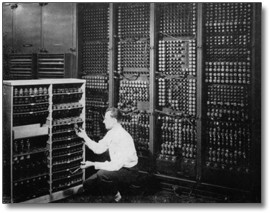A Brief History of Computers

By Valinda Huckabay
Computer HistoryBefore 1935, the term “computer” referred to a person who performed numerical calculations using a mechanical calculator. Since then, the definition has changed to mean a machine, rather than a person that accepts input, processes data, stores data and produces output.
Computer Milestones in History
1896 – Developed by Herman Hollerith, the Tabulating Machine read and sorted data from punched cards. Hollerith formed the Tabulating Machine Company, which later became the International Business Machines Corporation (IBM).
1942 – Built at Iowa State by Professor John Atanasoff and Clifford Berry, the Atanasoff Berry Computer (ABC) weighed in at 750 lb. and had a memory storage of 3,000 bits (0.4K).
1944 – The Mark I was constructed by Harvard’s Professor Howard Aiken – it stood 50 feet long and 8 feet tall.
1946 – The ENIAC (Electronic Numerical Integrator and Computer) was the world’s first electronic computer. It weighed 30 tons and measured 50 x 30 feet. Since there was no software to reprogram the computer, it had to be rewired to perform different functions.
1951 – The UNIVAC (punch card technology) was introduced by Remington Rand. At over 40 systems sold, it was the first commercially successful computer. It used magnetic tapes that stored 1MB of data.
1969 – The Internet, originally the ARPAnet (Advanced Research Projects Agency network), began as a military computer network.
1976 – The CRAY 1, the world’s first electronic digital computer, was a 75MHz, 64-bit machine, the world’s fastest processor at the time. That same year, the Apple computer was designed by Steve Wozniak and Steve Jobs. Apple was the first to incorporate a graphical user interface and a computer mouse.
1978 – The age of PCs (personal computers) began. Many versions of desktop computers were developed by startup and existing companies all over the world.
1990 – Tim Berners-Lee invented the networked hypertext system called the World Wide Web.
1996 – PDAs (Personal Digital Assistants) became available to consumers. The first portable computing devices.
Computers Today
We use desktop and laptop computers at home, at work and for play, and depend on servers and the Internet for a multitude of reasons. Today, this vast interconnection of computers has expanded our resources, allowing us instant access to almost any recorded information.
Classroom discussion
- What do you think will be the next biggest invention in the computer world?
- What is the most productive task you perform with a computer?

